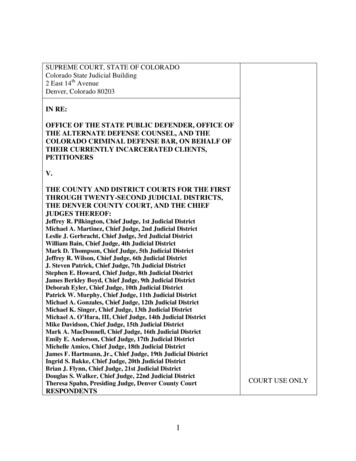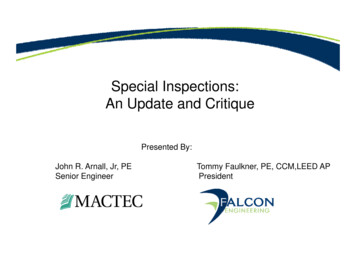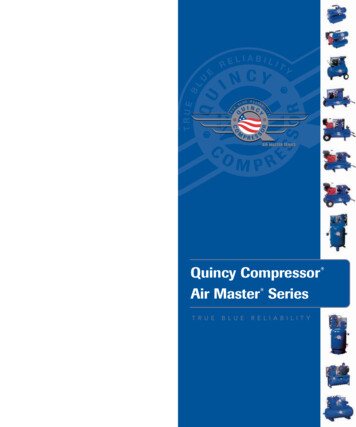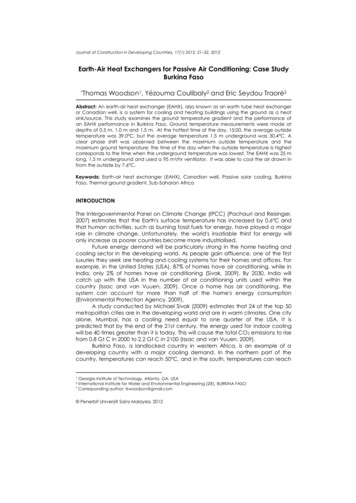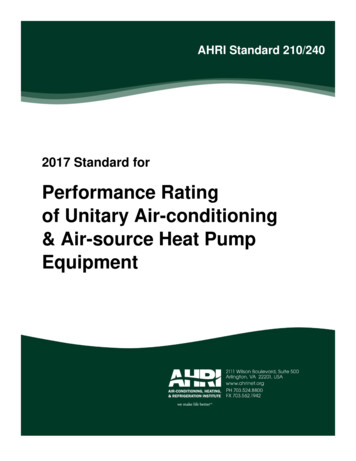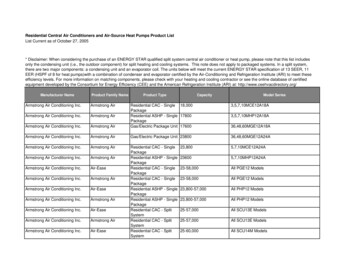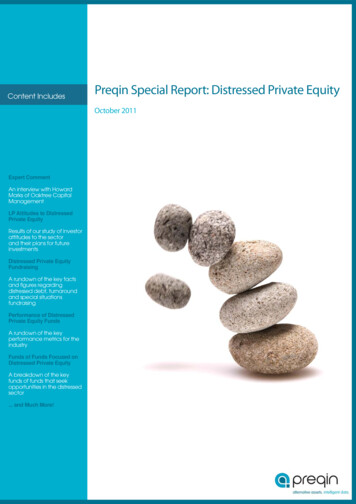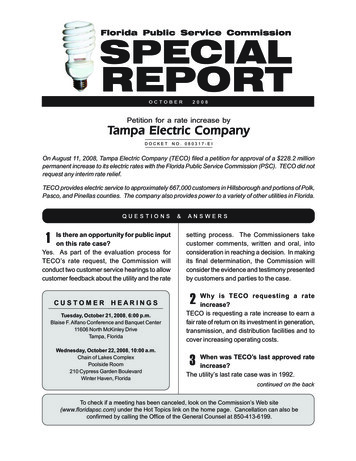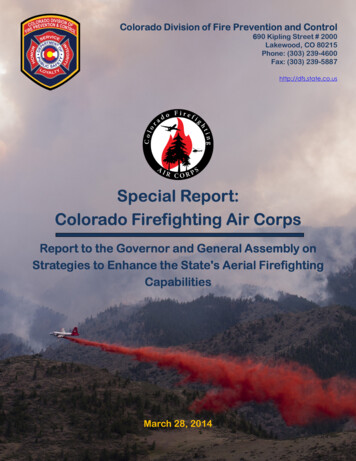
Transcription
Colorado Division of Fire Prevention and Control690 Kipling Street # 2000Lakewood, CO 80215Phone: (303) 239-4600Fax: (303) 239-5887http://dfs.state.co.usSpecial Report:Colorado Firefighting Air CorpsReport to the Governor and General Assembly onStrategies to Enhance the State's Aerial FirefightingCapabilitiesMarch 28, 2014
Division of Fire Prevention andControlPaul L. Cooke, Director690 Kipling Street, Suite 2000Denver, CO 80215(303) 239-4600FAX (303) 239-5887March 28, 2014John W. HickenlooperGovernor of Colorado136 State CapitolDenver, CO 80203Senator Morgan CarrollPresident of the Colorado Senate271 State CapitolDenver, CO 80203Representative Mark FerrandinoSpeaker of the Colorado House of Representatives346 State CapitolDenver, CO 80203Governor Hickenlooper, President Carroll, and Speaker Ferrandino:John W. HickenlooperGOVERNORJames H. DavisEXECUTIVE DIRECTORColorado State PatrolColorado Bureauof InvestigationDivision ofCriminal JusticeDivision of FirePrevention and ControlI am pleased to submit the final report of the special study concerning theColorado Firefighting Air Corps (CFAC) within the Division of Fire Prevention andControl (DFPC) in the Colorado Department of Public Safety. Senate Bill 13-245requires the DFPC to submit to the Joint Budget Committee and to the GeneralAssembly a report concerning the efficacy of CFAC and strategies to enhance thestate's aerial firefighting capabilities, prior to April 1, 2014. This report will includebudget requests for CFAC and aerial firefighting if recommended by the DFPC.To fulfill this mandate, I turned to the Advisory Committee to the Director of theDivision of Fire Prevention and Control on Wildland Fire and Prescribed FireMatters, which was created by Executive Order B 2013-001. An ad hoc "FireAviation Working Group", which included stakeholders as well as industry experts,was created under the Advisory Committee to focus on Colorado's aerialfirefighting capabilities.Division of Homeland Securityand Emergency ManagementEarly in the preparation of this report it was apparent that information that iscritical for guiding policy, strategy, and decisions regarding the management ofwildfire is not sufficient, accessible, or readily available. Thus, a keyrecommendation concerns the implementation of an integrated informationmanagement system to ensure the maximum effectiveness of current and futureresources."Safeguarding those that live, work, learn and play in Colorado"
Colorado Division of Fire Prevention and ControlRecommendations concerning improvements in Colorado's aerial firefighting capabilities werenot based exclusively on gaps in the federal interagency aviation system, but rather on DFPC'swildfire management goal, which is to:"Keep all wildfires with values at risk smaller than 100 acres andto suppress all fires in Wildland Urban Interface (WUI) areas atless than ten acres, 98% of the time."Because DFPC's role is primarily to support local and county firefighting organizations, in orderto achieve this wildfire management goal accomplishment of the following enabling goals willbe necessary: Generate an incident assessment for every fire within 60 minutes of report or detection. Deliver the appropriate aviation suppression resources to every fire within 60 minutesof the request.Key to achieving DFPC's wildfire management goal is developing the capability to detect firesearlier, locate them faster, provide the local Incident Commander with data needed to makeinformed decisions regarding suppression strategy, and then dispatch the appropriate aviationsuppression resources expeditiously.In order meet these wildfire management goals, the following improvements in Colorado'sfirefighting capabilities are recommended: Colorado should procure and train fire managers in the state to use an off-the-shelfwildfire information management system. In order achieve the goal of generating an incident assessment for every fire within 60minutes of report or detection of a wildfire Colorado should procure and operate twofixed-wing multi-mission aircraft. In order achieve the goal of providing the appropriate aviation suppression resources toevery fire within 60 minutes of the request Colorado should:o contract for the exclusive use of four Type 3 or larger rotor-wing aircraft; ando increase the exclusive use single engine air tankers (SEAT) contract to fouraircraft. Instead of procuring state-owned air tankers, Colorado should identify and contract forthe use of existing air tanker systems during the fire season. An exclusive use contractfor two Type 2 or larger air tankers is recommended.Page 2
Colorado Division of Fire Prevention and ControlOther Recommendations DFPC should evaluate the benefits, opportunities, costs, and risks associated withimplementing an "Agricultural Aircraft-Based Rapid Response Aerial Firefighting Program"for Colorado. DFPC should explore ways to further incorporate Colorado National Guard rotor-wing assetsas a standing wildland firefighting resource for initial or extended attack. DFPC should work to ensure all firefighters are provided the appropriate training,equipment and facilities necessary to successfully and safely meet the increasinglycomplicated and challenging wildfire and emergency response environment.The improvements and capabilities recommended by this report will not ensure that Coloradowill be free of wildfires. Even under the most highly effective wildland fire protection systemssome fires will continue to escape control efforts. Under extreme weather conditions, such asthose ignited during high wind events, or when resource availability is limited due to significantfire activity, a small percentage of wildland fires will become large and damaging. As a result,efforts must be taken to create homes and communities that can withstand such fires; developpolicies and procedures to promote public and firefighter safety; and educate the public thatwildland fire is a natural part of Colorado’s landscape.The improvements and capabilities recommended by this report will have a positive effect onwildfire suppression response and will improve Colorado’s ability to act on fires in a moreefficient, effective, and elegant manner. The recommendations in this report are likely todecrease the losses suffered as a result of wildfire in Colorado as well as the overall cost of firesuppression and post-fire recoveryI stand ready to answer any questions you may have concerning the recommendationscontained in this report.Respectfully Submitted,Paul L. CookeDirectorPage 3
Special Report:Colorado Firefighting Air CorpsReport to the Governor and General Assembly onStrategies to Enhance the State's Aerial FirefightingCapabilitiesPaul L. Cooke, DirectorColorado Division of Fire Prevention and Control690 Kipling Street # 2000Lakewood, CO 80215(303) 239-4600http://dfs.state.co.usCover PhotoHigh Park Fire – A fixed wing aircraft drops a load of fire retardant on a dozer line to prevent the firefrom crossing into a residential area. (Official U.S. Army photo by Sgt. Jecca Geffre / June 19, 2012)
SPECIAL REPORT – COLORADO FIREFIGHTING AIR CORPSACKNOWLEDGEMENTSI wish to express my gratitude to the many individuals who made the production of this Reportpossible. There are so many to thank, and on a project of this scale there is significant risk offorgetting someone, so I will begin by apologizing if your name was inadvertently left off thelist.Next, I want to highlight the commitment that members of the "Advisory Committee to theDirector of the Division of Fire Prevention and Control on Wildland Fire and Prescribed FireMatters" and the ad hoc "Fire Aviation Working Group" made to this process.1 The AdvisoryCommittee and Working Group members, as well as other stakeholders attended severalmeetings and working group sessions, provided thoughtful comments, and engaged in spiriteddiscussions over the last eight months.I also wish to recognize the tireless efforts of DFPC staff members, specifically Jane Lopez,Deputy Section Chief – Wildland Fire Planning (Aviation and Prescribed Fire); Cliff White, DFPCSeat Manager; Rocco Snart, Acting Chief - DFPC Wildland Fire Section; and Vaughn Jones, ActingDeputy Section Chief – Wildland Fire Operations. Additionally, I want to thank MelissaLineberger, DFPC Policy Analyst, for her work as the Editor of the Report.The Advisory Committee and Working Group were fortunate to hear many presentations,including:2USFS Aerial Firefighting Briefing & Strategic Management of Large AirtankersRon Hanks, National Aviation Operations and Quality AssuranceKim Christensen, USFS Deputy Director of OperationsCAL-FIRE’s Aviation ProgramJohn Winder, Assistant Deputy Director for Fire Protection Operations, CAL-FIRECenter of Excellence for Advanced Aerial FirefightingPerspective of Dr. Tony Kern, former USFS National Aviation DirectorFire Aviation AlternativesPerspective of Tom Landon, former USFS Regional Aviation OfficerDynCorp & Argon ST Aircraft Systems PresentationJeff Cavarra, Jason Rossbach, Scott Rauer, Scott Harvey, and Paul Wynns1See Appendix D for list of members of the Advisory Committee to the Director of the Division of Fire Preventionand Control on Wildland Fire and Prescribed Fire Matters and the ad hoc "Fire Aviation Working Group".2Many more presentations on particular products and services were attended to by DFPC management and staff.Page i
SPECIAL REPORT – COLORADO FIREFIGHTING AIR CORPSSierra Nevada Corporation PresentationCaleb Freeman, Principal EngineerCoulson Fire Aviation PresentationWayne Coulson, CEOHelicopter Night Flying in Fire SuppressionDennis Hulbert, Retired US Forest Service Regional Aviation Officer10 Tanker Air Carrier (DC-10 Program Review)John Gould, President, 10 Tanker Air Carrier, LLC.State of Oregon Fire Aviation ProgramDoug Grafe, Fire Operations Manager, Oregon Department of ForestryState Fire Aviation & Interstate Fire CompactsDan Smith, Fire Director, National Association of State ForestersThe National Cohesive Wildland Fire Management Strategy: Western Regional Action PlanAnn Walker, Western Governors’ AssociationWildland Fire Information Management SystemBrian Collins, Intterra Inc.Beriev 200 (Be-200) Multipurpose Amphibious JetInternational Emergency Services, Inc.Integrated Wildland Fire Mapping, Monitoring, and ModelingDr. Janice Coen & William Mahoney, National Center for Atmospheric ResearchPreparation of this Report was also aided significantly from input by a number of subject matterexperts, including:Mike Amicarella, BIA Central Regional Aviation ManagerGlenn Barter, USFS Rocky Mountain Area Coordination CenterScott Fisher, Chairman, Interagency Airtanker Board, USDA Forest ServiceCaleb Freeman, Principal Engineer, Sierra Nevada CorporationJ. Kent Hamilton, Regional Aviation Safety Manager, USFS Rocky Mountain RegionRon Hanks, Federal Fire and Aviation Safety Team (FFAST)Marsha Henderson, State Fire Operations, State of AlaskaJoel Kerley, National Aviation Manager, Bureau of Indian AffairsDr. Tony Kern, CEO, Convergent PerformanceJim Lawson, USFS Helicopter Operations SpecialistP a g e ii
SPECIAL REPORT – COLORADO FIREFIGHTING AIR CORPSSandra LaFarr, USFS Regional Aviation OfficerThomas Landon, CEO, Landon’s Landing LLC, USFS (ret)Brooke Malcolm, U.S. Fish and Wildlife Service – Region 6Marco Perea, BLM Fire Management Specialist, RMACCWilliam B. Scott, CEO, Scott Systems, LLCMark Sirangelo, Chief Innovation Officer, Office of Governor HickenlooperLt. Col. Luke Thompson, Chief of Aerial Firefighting, US Air Force ReserveJohn Winder, Assistant Deputy Director for Fire Protection Operations, CAL-FIRE (ret)Michael Yadon, FedEx CorporationDouglas Young, Senior Policy Director, Office of Governor HickenlooperEric Zanotto, District FMO, Pike and San Isabel National ForestFinally, I am especially grateful for the participation of the Western Governors’ Association,and, in particular, Ann Walker, Forest & Rangeland Health Program Manager, who attendedmany meetings, consulted with DFPC staff, and helped organize several of the presentations.Without the assistance of each of these individuals and sponsoring organizations, we could nothave met our statutory obligations.Sincerely,Paul L. Cooke, DirectorColorado Division of Fire Prevention and ControlP a g e iii
SPECIAL REPORT – COLORADO FIREFIGHTING AIR CORPSTABLE OF CONTENTSPageIntroduction . . . . . . . . . . . . . . . . . . . . . . . . . . . . . . . . . . . . . . . . . . . . . . . . . . . . . . . . . . . . . .1Executive Summary . . . . . . . . . . . . . . . . . . . . . . . . . . . . . . . . . . . . . . . . . . . . . . . . . . . . . . . .2Summary of Recommendations to Address Findings . . . . . . . . . . . . . . . . . . . . . . . . . . . . .4Background . . . . . . . . . . . . . . . . . . . . . . . . . . . . . . . . . . . . . . . . . . . . . . . . . . . . . . . . . . . . . . .6Wildfire in Colorado . . . . . . . . . . . . . . . . . . . . . . . . . . . . . . . . . . . . . . . . . . . . . . . . . . . . . . . .6Forest Conditions . . . . . . . . . . . . . . . . . . . . . . . . . . . . . . . . . . . . . . . . . . . . . . . . . . . . . . . .6Wildland-Urban Interface (WUI) Challenges . . . . . . . . . . . . . . . . . . . . . . . . . . . . . . . . . .6Colorado's Fire History and Future . . . . . . . . . . . . . . . . . . . . . . . . . . . . . . . . . . . . . . . . .7Lengthening of Colorado's Wildfire Seasons . . . . . . . . . . . . . . . . . . . . . . . . . . . . . . . . . .8Increasing Wildfire Costs . . . . . . . . . . . . . . . . . . . . . . . . . . . . . . . . . . . . . . . . . . . . . . . . . .9Wildfire Impacts on Watershed . . . . . . . . . . . . . . . . . . . . . . . . . . . . . . . . . . . . . . . . . . . .10Colorado's Wildfire Management Goal . . . . . . . . . . . . . . . . . . . . . . . . . . . . . . . . . . . . . . . .11Challenges in Meeting These Goals . . . . . . . . . . . . . . . . . . . . . . . . . . . . . . . . . . . . . . . . . . .12Information Availability . . . . . . . . . . . . . . . . . . . . . . . . . . . . . . . . . . . . . . . . . . . . . . . . . .12Early Detection and Remote Sensing Capability . . . . . . . . . . . . . . . . . . . . . . . . . . . . . . .13Initial Attack Assets . . . . . . . . . . . . . . . . . . . . . . . . . . . . . . . . . . . . . . . . . . . . . . . . . . . . . .14Difficult Terrain . . . . . . . . . . . . . . . . . . . . . . . . . . . . . . . . . . . . . . . . . . . . . . . . . . . . . . . . .14Consistent Risk Management Strategy . . . . . . . . . . . . . . . . . . . . . . . . . . . . . . . . . . . . . .14Resource Availability . . . . . . . . . . . . . . . . . . . . . . . . . . . . . . . . . . . . . . . . . . . . . . . . . . . . .14Large Air Tanker Employment and Availability . . . . . . . . . . . . . . . . . . . . . . . . . . . . . . . .15Colorado's Current Firefighting System . . . . . . . . . . . . . . . . . . . . . . . . . . . . . . . . . . . . . . . .16Organization . . . . . . . . . . . . . . . . . . . . . . . . . . . . . . . . . . . . . . . . . . . . . . . . . . . . . . . . . . . .16Colorado’s Current Firefighting Capability . . . . . . . . . . . . . . . . . . . . . . . . . . . . . . . . . . .17Current Wildfire Aviation Resources in Colorado . . . . . . . . . . . . . . . . . . . . . . . . . . . . . .18Current Status of Federal Aerial Resources . . . . . . . . . . . . . . . . . . . . . . . . . . . . . . . . . . .20The State's Supplemental Resources . . . . . . . . . . . . . . . . . . . . . . . . . . . . . . . . . . . . . . . .21Recommendations Regarding Aviation Resources . . . . . . . . . . . . . . . . . . . . . . . . . . . . . . . .24Fixed Wing Large Air Tankers . . . . . . . . . . . . . . . . . . . . . . . . . . . . . . . . . . . . . . . . . . . . . .24Multi-Mission Fixed Wing Aircraft . . . . . . . . . . . . . . . . . . . . . . . . . . . . . . . . . . . . . . . . . .24Page v
SPECIAL REPORT – COLORADO FIREFIGHTING AIR CORPSRotor-Wing Multi-Mission Aircraft . . . . . . . . . . . . . . . . . . . . . . . . . . . . . . . . . . . . . . . . . .25Single Engine Air Tankers . . . . . . . . . . . . . . . . . . . . . . . . . . . . . . . . . . . . . . . . . . . . . . . . .25Agricultural Aircraft-Based Rapid Response Aerial Firefighting Program . . . . . . . . . . .25Other Aviation Options Examined . . . . . . . . . . . . . . . . . . . . . . . . . . . . . . . . . . . . . . . . . . . . .27State Ownership of Large Air Tanker Fleet. . . . . . . . . . . . . . . . . . . . . . . . . . . . . . . . . . . .27Conversion of Surplus Military Aircraft . . . . . . . . . . . . . . . . . . . . . . . . . . . . . . . . . .Donated Commercial Aircraft . . . . . . . . . . . . . . . . . . . . . . . . . . . . . . . . . . . . . . . . .2730Unmanned Systems for Remote Sensing and Persistent Monitoring . . . . . . . . . . . . . .33Other Recommendations Regarding Wildfire Goals . . . . . . . . . . . . . . . . . . . . . . . . . . . . . .34Provide an Information Management System Tool . . . . . . . . . . . . . . . . . . . . . . . . . . . .34Risk Management and Pre-Planning Strategy . . . . . . . . . . . . . . . . . . . . . . . . . . . . . . . . .35Continued Effectiveness Monitoring . . . . . . . . . . . . . . . . . . . . . . . . . . . . . . . . . . . . . . . .35Intended Effects of Recommendations . . . . . . . . . . . . . . . . . . . . . . . . . . . . . . . . . . . . . . . . .35Waldo Canyon Fire . . . . . . . . . . . . . . . . . . . . . . . . . . . . . . . . . . . . . . . . . . . . . . . . . . . . . .36High Park Fire . . . . . . . . . . . . . . . . . . . . . . . . . . . . . . . . . . . . . . . . . . . . . . . . . . . . . . . . . . .36Detailed Recommendations . . . . . . . . . . . . . . . . . . . . . . . . . . . . . . . . . . . . . . . . . . . . . . . . .38Information Management System . . . . . . . . . . . . . . . . . . . . . . . . . . . . . . . . . . . . . . . . . .38Risk Management and Pre-Planning Strategy . . . . . . . . . . . . . . . . . . . . . . . . . . . . . . . . .40Multi-Mission Fixed Wing Aircraft . . . . . . . . . . . . . . . . . . . . . . . . . . . . . . . . . . . . . . . . . .40Rotor-Wing Multi-Mission Aircraft . . . . . . . . . . . . . . . . . . . . . . . . . . . . . . . . . . . . . . . . . .46Single Engine Air Tankers . . . . . . . . . . . . . . . . . . . . . . . . . . . . . . . . . . . . . . . . . . . . . . . . .47Fixed Wing Large Air Tankers . . . . . . . . . . . . . . . . . . . . . . . . . . . . . . . . . . . . . . . . . . . . . .47Program Structure . . . . . . . . . . . . . . . . . . . . . . . . . . . . . . . . . . . . . . . . . . . . . . . . . . . . . . . . .48Contracting Model . . . . . . . . . . . . . . . . . . . . . . . . . . . . . . . . . . . . . . . . . . . . . . . . . . . . . . .48Infrastructure Requirements . . . . . . . . . . . . . . . . . . . . . . . . . . . . . . . . . . . . . . . . . . . . . . . . .49Schedule . . . . . . . . . . . . . . . . . . . . . . . . . . . . . . . . . . . . . . . . . . . . . . . . . . . . . . . . . . . . . . . . .490-6 Months After Program Initiation . . . . . . . . . . . . . . . . . . . . . . . . . . . . . . . . . . . . . . . .496-18 Months After Program Initiation . . . . . . . . . . . . . . . . . . . . . . . . . . . . . . . . . . . . . . .4918-36 Months After Program Initiation . . . . . . . . . . . . . . . . . . . . . . . . . . . . . . . . . . . . . .49Cost Estimate . . . . . . . . . . . . . . . . . . . . . . . . . . . . . . . . . . . . . . . . . . . . . . . . . . . . . . . . . . . . .50Call When Needed Contract for Large Air Tankers . . . . . . . . . . . . . . . . . . . . . . . . . . . . .51P a g e vi
SPECIAL REPORT – COLORADO FIREFIGHTING AIR CORPSTotal Budgetary Needs . . . . . . . . . . . . . . . . . . . . . . . . . . . . . . . . . . . . . . . . . . . . . . . . . . .51Other Opportunities . . . . . . . . . . . . . . . . . . . . . . . . . . . . . . . . . . . . . . . . . . . . . . . . . . . . . . .52Joint Procurement and Operation of Aircraft
o contract for the exclusive use of four Type 3 or larger rotor-wing aircraft; and o increase the exclusive use single engine air tankers (SEAT) contract to four aircraft. Instead of procuring state-owned air tankers, Colorado shoul
